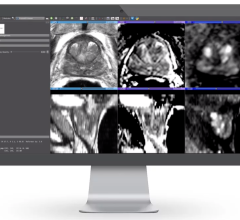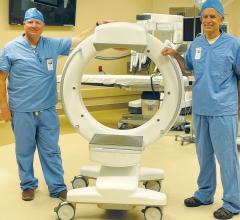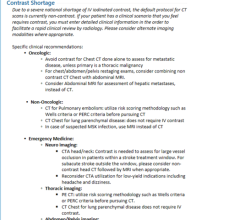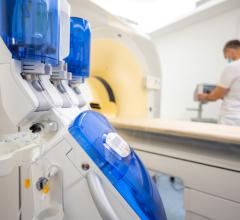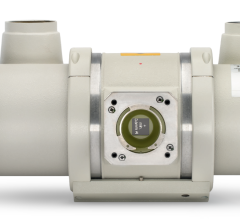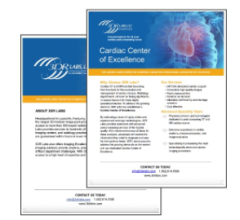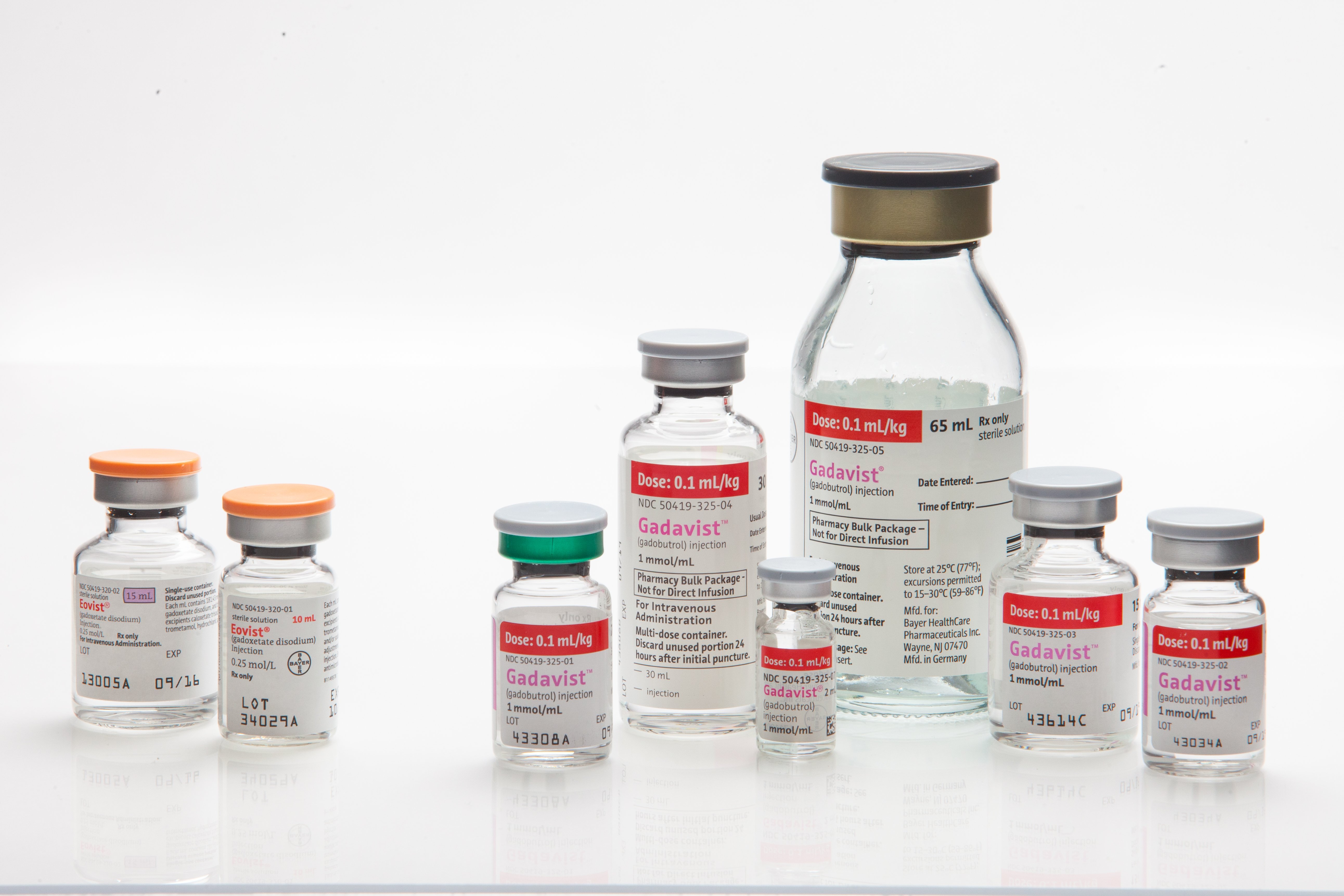
Here are several updates in medical imagingcontrast media agents.其中最大的两项新闻是关于磁共振成像(MRI)钆剂和超声心动图造影剂的安全性问题。然而,在这两种情况下,美国食品和药物管理局(FDA)都认为这些药物对大多数患者是安全的。
Concern Over MRI Gadolinium Agents Retained in Brain
在过去的十年中,一些临床研究表明钆基MRI造影剂会在患者体内组织中积累。这引起了人们的关注,因为体内长期升高的钆水平可能会导致严重肾病患者的肾源性全身纤维化。2015年的三项研究加剧了这种担忧,在发现钆还会在大脑中积聚后,这些研究提出了新的安全问题。
On its own, gadolinium can be toxic. Therefore, when used in contrast agents, gadolinium is bonded with a molecule called a chelating agent, which controls the distribution of gadolinium within the body. It was thought, prior to 2006, that gadolinium was completely excreted from the body. In patients found to retain traces of the agent, it was believed it was due to severe renal dysfunction. However, the 2015 brain studies found gadolinium retention in the brain also occurred in patients with normal renal function.[1,2] Another 2015 study from the University of Heidelberg Medical Center in Heidelberg, Germany, suggests that the molecular structure of the contrast agent may play a role in gadolinium retention.[3] There are two structurally distinct categories of gadolinium-based contrast agents: linear and macrocyclic. In the macrocyclic structure, the gadolinium is bound more tightly to the chelating agent and, therefore, less likely to release free gadolinium into the body.
However, no studies have yet shown that retained gadolinium in the brain causes negative long term-health effects. This was the determination of the FDA review of the safety ramifications of gadolinium-based contrast agents, released in a drug safety communication in May 2017. The FDA said it has not identified adverse health effects from gadolinium retained in the brain. The FDA said there is no evidence to date that gadolinium retention in the brain from any of the gadolinium agent is harmful, so restricting use of these agents is not warranted at this time. FDA said it will continue to assess the safety of these agents. The FDA reported that studies show linear agents retain more gadolinium in the brain than macrocyclic agents. However, the review did not identify adverse health effects related to this brain retention.
The agency said the agents should be used as is appropriate when considering the use of any medical imaging agent. It also stated healthcare professionals should limit gadolinium contrast use to circumstances in which additional information provided by the contrast agent is necessary and to assess the necessity of repetitive MRIs.
View a comparison chart of MRI contrast agents.This will require a login, but it is free and only takes a minute to complete.
Echo Contrast Updates
Echocardiography experts say up to 20 percent of all resting echocardiography studies, and up to 30 percent of those conducted in critical care patients, can result in suboptimal echocardiograms. A suboptimal image is one in which two or more contiguous left ventricular segments in any of the three apical views cannot be visualized. The use of contrast in suboptimal echocardiograms can improve the diagnostic quality of these otherwise suboptimal exams.[4,5,6]
Echo contrast agents consist of perflutren lipid or protein microspheres. They contain gas, such as a high-molecular weight perfluorocarbon, which aids in reflecting ultrasound waves and in the stability of the spheres. These micro-bubbles are between 1-8 microns in size, allowing them to pass through the microcirculation.
In the past there was concern about the microspheres embolizing, which was why the FDA issued a “black-box” warning for Lantheus Medical Imaging’s Definity and GE Healthcare’s Optison agents in October 2007. This followed 11 deaths that appeared to be related to the agents. The warning contraindicated use in patients with worsening or unstable heart failure, acute myocardial infarction or serious ventricular arrhythmias and in conditions that cause pulmonary hypertension. However, these events occurred over a period of six years and it was not clear if the contrast was the cause. Thirty minutes of close monitoring with vital signs and ECG after contrast administration were required, and the use of echo contrast use plummeted.
The FDA revised these guidelines in May 2008 and replaced the extended contraindications with warnings after recognizing the favorable risk/benefit ratio for these contrast agents and the potential risks of alternative procedures. The FDA also considered evidence from several clinical studies initiated after the black box warning, showing the agents had a very good safety profile. Since then, use of echo contrast has been on the rebound.
A lingering contraindication due to the fear of embolization has been a ban on using echo contrast agents if there is a right-to-left or bidirectional cardiac shunt. The restrictions on patients with shunts was lifted for Optison in October 2016, and for Definity in February 2017. Previously, in suspected cardiac shunt populations, an agitated saline procedure was needed to determine if a shunt existed and whether the patient was contraindicated to receive an ultrasound contrast agent.
At the same time, the FDA also expanded Optison’s indication, allowing for administration by intra-arterial injection.
“Up to one-third of our patients have known or suspected cardiac shunts and, thanks to this important FDA decision, they too will now have access to ultrasound contrast agents, which offer an inexpensive and radiation-free option for diagnostic imaging,” said Steven Feinstein, M.D., co-president of the International Contrast Ultrasound Society. “We applaud the FDA for its decision, and we believe it will benefit individual patients as well as our healthcare delivery system.”
Jonathan Lindner, M.D., M. Lowell Edwards Professor of Cardiology at the Knight Cardiovascular Center, Oregon Health & Science University, said at the time of the FDA announcement that there was an overwhelming amount of evidence from clinical trials and most practitioners in the field of echocardiography already knew the benefits of using echo contrast. “However, a major obstacle to widespread use has been lack of consensus and confusion regarding how far one needs to go to exclude shunts, no matter how small,” he explained. “The decision by the FDA removes a barrier to using this contrast agent, and may result in an increase in the number of labs that will choose to utilize this important technology, which allows clinicians to provide the best care possible.”
In October 2014, the FDA cleared a third echo contrast agent, Bracco’s Lumason (sulfur hexafluoride lipid microsphere). The first U.S. imaging procedures took place in May 2015. The agent is supplied as a three-part kit. Also in 2015, Lumason was approved by the Centers for Medicare and Medicaid Services (CMS) for pass-through payment status under the Hospital Outpatient Prospective Payment System (HOPPS). The agent comes in a kit containing a Lumason vial with 25 mg of lipid-type A lyophilized powder and 60.7 mg sulfur hexafluoride headspace, a prefilled syringe containing 5 mL of sodium chloride 0.9 percent injection, USP (Diluent) and a mini-spike.
View a comparison chart of echo contrast agents.This will require a login, but it is free and only takes a minute to complete.
New Contrast Agents, Indications
In May 2017, the FDA expanded the indication for GE Healthcare’s Visipaque (iodixanol) 320 mg iodine/mL injection for use in coronary computed tomography angiography (CCTA) for diagnostic evaluation of adult and pediatric patients 12 years of age or older with suspected coronary artery disease. The new CCTA indication allows physicians to non-invasively image the coronary arteries, rather than use of traditional invasive coronary angiography to diagnose coronary artery disease.
“Coronary heart disease is a major cause of death in the United States,” saidMatt Budoff, M.D., FACC, director of cardiac CT and professor of medicine, Harbor-UCLA Medical Center, Torrance, Calif. “We are excited about the label extension of Visipaque as the first FDA approved iodinated contrast media for use in CCTA. Having an approved contrast agent for CCTA may facilitate the use of CCTA as a gatekeeper to invasive coronary angiography in patients with mild to moderate coronary artery disease, sparing patients from a more invasive procedure and long recovery times.”
FDA cleared Bayer’s Gadavist (gadobutrol) injection for use with magnetic resonance angiography (MRA) to evaluate known or suspected supra-aortic or renal artery disease, in April 2016. The injection was approved for use in adult and pediatric patients (including term neonates).
“到目前为止,没有一种造影剂被fda批准用于主动脉上动脉的MRA,”马里兰大学诊断放射学和核医学系主任、GEMSAV研究的主要研究员Elias Melhem医学博士说,他过去曾获得新的批准。随着FDA的行动,放射科医生现在有了一种经批准的MRA造影剂,以帮助已知或怀疑有主动脉上动脉疾病的患者(包括先前的中风或短暂性脑缺血发作(TIA))的主动脉上动脉可视化。”
GEMSAV (gadavis - enhanced MRA of The上主动脉)研究评估了457名已知或怀疑患有上主动脉疾病的患者。疗效评估基于视觉和表现区分正常和异常解剖。显著狭窄被定义为至少70%。数据显示,Gadavist MRA在三个阅读器上显著提高了88% - 97%的可视化,相比之下,未增强MRA仅提高了24% - 82%。
In January 2015, the FDA approved Gadavist for use with MRI in pediatric patients less than 2 years of age, including term neonates, to detect and visualize areas with disrupted blood brain barrier and/or abnormal vascularity of the central nervous system. Gadavist was previously approved in 2011 for this use in patient populations over the age 2. The FDA’s priority review was based on a study showing that the pharmacokinetic (PK) and safety profiles in pediatric patients less than 2 years of age were similar to that of older children and adults at standard dose (0.1 mmol/kg).
查看CT和血管造影用碘造影剂的对比图。This will require a login, but it is free and only takes a minute to complete.
New Types of Contrast Packaging
There have been a few innovations in contrast agent packaging over the past few years, including bulk, multi-dose containers and polymer containers.
2014年11月,Bracco Diagnostics发布了Isovue (iopamidol注射剂)成像批量包(IBP),这是FDA批准的一种多患者、多剂量匹配的特殊组合造影剂,可用于计算机断层扫描(CT)套件的即时使用。IBP的设计旨在提高安全性和改善工作流程,同时将多剂量CT造影剂的使用风险降至最低并保持依从性。用于多剂量造影剂的药品散装包装(PBPs)最初在20世纪90年代获得批准,并附有处方信息,用于“使用无菌(无菌)技术的合适工作区域,如层流罩”,通常在医院药房设置中发现。随着时间的推移,负责对全国医疗机构进行认证和认证的联合委员会开始向医疗中心发出传票,要求其在不完全符合处方信息的情况下使用PBPs将造影剂转移到药房外。2012年,安全用药规范研究所呼吁医院药房监督静脉注射造影剂的购买、分发、储存和使用,放射性用途的单剂量瓶或预充注射器的使用,以及PBPs的正确使用。Isovue IBP使CT成像的静脉造影增强容易且经济有效,可从同一容器提供10小时按需给药,而不会产生多次给药的风险。
Some vendors offer polymer bottles rather than the traditional glass packaging. Several years ago GE Healthcare introduced its +PlusPak plastic packaging container for contrast media, which the vendor said offers advantages over traditional glass packaging. This includes reduced storage, improved workplace safety for healthcare workers who administer contrast media to patients, and decreased cost of waste disposal. Radiology departments using the lighter-weight packaging can reduce contrast media red bag waste weight by more than 75 percent. The unbreakable polypropylene bottles feature a metal-free, twist-off cap that is easy to open and avoids cuts from metal crimps, reducing time spent treating sharps injuries while also reducing the associated risk of bloodborne pathogen transmission.
Mallinckrodt Acquisition by Guerbet, Removes Two products From Market
The contrast media market is made up of only a small number of players, and that pool got smaller in July 2015 when Guerbet acquired Mallinckrodt's contrast media and delivery systems (CMDS) business for $270 million. Guerbet said CMDS business was well positioned with Optiray and Optiject (Europe)/Ultraject (United States) in X-ray, whereas Guerbet holds a similar position in MRI with its Dotarem agent. The acquisition opened up technological synergies, with the Mallinckrodt's syringe-based delivery systems and Guerbet’s hydraulic injection technique for softbags. The businesses were also geographically complementary, with the Mallinckrodt's business holding a strong position in the United States and Guerbet likewise in Europe.
2017年7月,Guerbet宣布将在全球范围内逐步停止两种产品的销售:Hexabrix(三聚氰胺和碘氧化钠)和Optimark(加oversetamide)。该公司表示,在收购了Mallinckrodt的造影剂和传输系统业务后,这些产品是多余的。2015年,Guerbet宣布在美国召回Hexabrix,这是一种用于x射线成像的碘化造影剂,与Guerbet的另外两种产品Optiray (ioversol)和Xenetix (iobitridol)具有相同的适应度。Hexabrix在欧洲、亚洲和拉丁美洲的销售将逐步停止,最迟将于2019年底停止。Optiray和Xenetix覆盖70多个国家。
Guerbet’s decision to phase out Optimark is similar: Optimark and Dotarem (gadoteric acid) are both gadolinium-based contrast agents and have similar indications for magnetic resonance imaging (MRI). Optimark is a linear agent and faces decreasing worldwide demand, while Dotarem, a macrocyclic and ionic agent, has seen worldwide demand increase, according to the company. Dotarem is registered in more than 70 countries. Sales of Optimark will end July 26, 2017, in European Union countries. Then, and in order to ensure a smooth transition and continuous supply for patients, Optimark phase-out will be progressively implemented in other geographic areas until the end of 2019.
This move to streamline its gadolinium-based contrast agent portfolio through a focus on Dotarem is consistent with recent recommendations of the Pharmacovigilance Risk Assessment Committee (PRAC) of the European Medicines Agency.
Related Content Links:
Watch the VIDEO “MRI Gadolinium Contrast Retention in the Brain.”伊曼纽尔·卡纳尔,医学博士,核磁共振服务主任,匹兹堡大学医学中心放射学和神经放射学教授,解释了核磁共振造影在大脑中的保留和其他核磁共振安全问题。
FDA: No Harm in MRI Gadolinium Retention in the Brain
Understanding Contrast-Induced Nephropathy
For more information on contrast agents:
References:

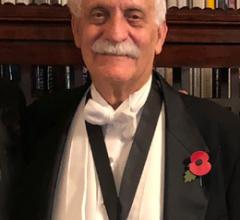
 August 10, 2022
August 10, 2022
